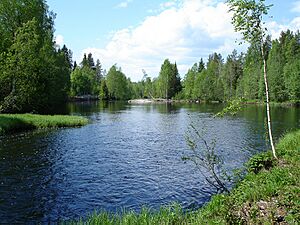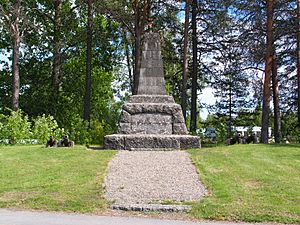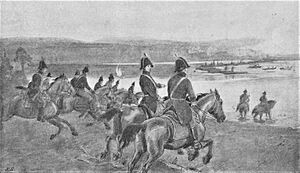Battle of Sävar facts for kids
Quick facts for kids Battle of Sävar |
|||||||
|---|---|---|---|---|---|---|---|
| Part of the Finnish War (Napoleonic Wars) | |||||||
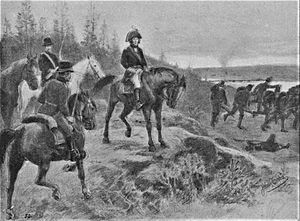 Wachtmeister at Sävar, by Johan Tirén |
|||||||
|
|||||||
| Belligerents | |||||||
| Commanders and leaders | |||||||
| Strength | |||||||
| 4,644 10 guns |
5,500 8 guns |
||||||
| Casualties and losses | |||||||
| Swedish source: 850 killed, wounded or captured Russian source: 2,000 killed, wounded or captured |
Russian source: 1,400 killed, wounded or captured |
||||||
The Battle of Sävar was a fight between Swedish and Russian armies on August 19, 1809. It was part of the Finnish War and was the very last major battle fought on Swedish land. After Russia took over eastern Sweden (which is now Finland) in 1808, the Swedish forces had to pull back to Sweden.
In March 1809, the Russian Emperor Alexander I attacked Sweden. He wanted Sweden to join the Continental System (a trade blockade against Britain) and give Finland to Russia. Even though Russia had some early wins, the war didn't end quickly. After more fighting in northern Sweden, Russian forces led by Nikolay Kamensky took control of all of Västerbotten by June.
Sweden was ready to give up Finland, but they didn't agree on the new border. To get better terms, Sweden planned a special mission to Västerbotten. Their idea was to land troops at Ratan to cut off Kamensky's army from Russian-controlled Finland. At the same time, another Swedish force would attack from the south. This way, Kamensky's army would be trapped between the two Swedish groups.
The Swedish troops landed at Ratan on August 17. Their army, led by Gustaf Wachtmeister, marched south towards Umeå. But Wachtmeister was too careful and moved very slowly. He didn't reach Umeå before Kamensky had already passed through the city. Kamensky then marched straight towards Wachtmeister to break free from the trap.
On August 19, the Swedish army was attacked at Sävar in a bad position. Instead of pulling back across the river, Wachtmeister decided to fight for some important high ground called Krutbrånet. More fighting happened further south. Around midday, Wachtmeister pulled his troops back across the river. Kamensky sent more troops over the river, and the fighting continued. Wachtmeister decided to retreat at 2:45 PM. This battle was one of the bloodiest of the war.
Instead of going to Djäkneboda as planned, Wachtmeister fell back to Ratan. This allowed the Russians to use the main road north and escape the trap. Kamensky sent a force to attack the Swedes at Ratan the next day to cover his retreat. The Swedish mission failed to destroy Kamensky's army, but it did force them out of Västerbotten. Later, in the Treaty of Fredrikshamn, Sweden gave Finland to Russia. The Russians' demands were less harsh, likely because of this expedition.
Contents
Why the Battle Happened: Background
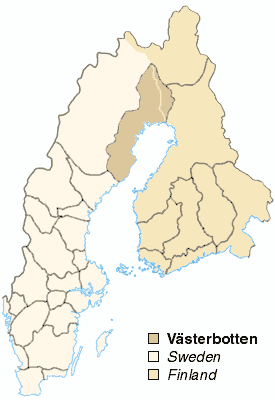
After a peace agreement in November 1808, the Swedish army left the eastern part of their kingdom (now Finland). In March 1809, during a time of big changes in Sweden, Emperor Alexander I of Russia ordered an attack on Sweden. He wanted Sweden to join a trade blockade against Britain and give up its eastern lands to Russia.
About 30,000 Russian soldiers took part in this attack. They forced Swedish armies to leave Åland and Umeå. Another Swedish force surrendered at Kalix. But despite these early wins, a new agreement was signed that stopped the Russian emperor from winning quickly.
Alexander I was upset that the talks were taking so long. He ordered more attacks in northern Sweden. In May, a small Swedish force was quickly defeated at the Battle of Skellefteå. This led to the Russians taking Umeå. So, the Russians occupied all of Västerbotten. They struggled to find food because the Swedes controlled the sea.
In July, Johan August Sandels led a Swedish counterattack at the Battle of Hörnefors. After this, the fighting slowed down as peace talks continued. Many Russian soldiers gave up and joined the Swedes. Later that month, Nikolay Kamensky took over as the main Russian commander. He planned to cross the Öre River and march into Ångermanland to get food.
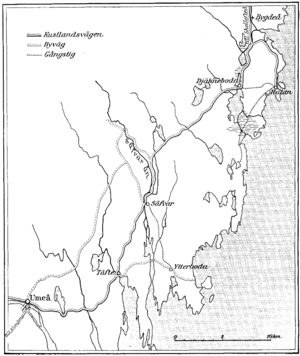
The Västerbotten Expedition: Sweden's Plan
Sweden had accepted losing its eastern lands. But they disagreed with Russia's demand for the border to be at the Kalix River. To get better peace terms, a Swedish war council decided on July 19 to launch a big attack. This attack would combine naval (sea) and land forces against Kamensky's troops in Västerbotten.
Sweden gathered about 10,300 to 11,000 men. The plan was for 6,800 men, led by Gustaf Wachtmeister, to land behind enemy lines. At the same time, Fabian Wrede and Sandels, with 4,000 men, would attack from the south. The goal was to trap the Russian army between the two Swedish forces. Kamensky's forces around Umeå had about 8,000 men.
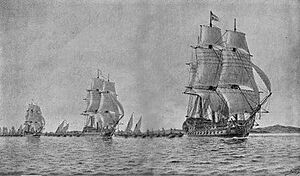
The Swedish fleet arrived outside Ratan on August 16. They started landing troops the next day. The Swedish commander, Johan af Puke, ordered Wachtmeister to march quickly south to retake Umeå. But Wachtmeister received wrong information about an enemy threat to the north. He sent a whole regiment and two guns to deal with it, which was unnecessary.
Further south, at Djäkneboda, about 420 Russians were quickly defeated by a smaller Swedish group. Wachtmeister was afraid of enemy attacks along the way. So, he made his army march very slowly, only about 2.5 kilometers (1.5 miles) an hour. He reached Sävar around midday on August 18 and decided to rest his troops there for a day and night. This was against Puke's orders for a quick march to Umeå. Soon, Wachtmeister learned that Kamensky had turned around and was marching straight towards him.
Kamensky heard about Wachtmeister's landing on August 17. He immediately stopped his march south and turned north to face the Swedes. He left some troops behind to trick Wrede into thinking he was still there. Unlike Wachtmeister, Kamensky marched very fast with his army. They passed through Umeå the next day. The Swedish fleet tried to destroy a bridge over the Ume River to slow the Russians down, but it failed without land support. The two Swedish generals didn't communicate well or work together. Kamensky reached Täfteå the next day and continued towards Sävar to attack Wachtmeister. Wachtmeister had sent a battalion to secure a side road. He stayed in a bad position that was open to attack from the south. If he had marched to Umeå or even Täfteå, he would have had a much better place to defend.
The Battle of Sävar: What Happened
Wachtmeister had 4,644 men and 10 guns. Kamensky's army had between 5,000 and 6,000 men with 8 guns. Only one of the three Swedish divisions was west of the Sävar River. The other two stayed on the east side. The first Swedish group set up outposts west of Sävar and on some important wooded hills called Krutbrånet. Wachtmeister called Krutbrånet "virtually a fortress." This is where the main fight would happen. The distance between Krutbrånet and the Sävar bridge was about 1 kilometer (0.6 miles) across open fields.
More Swedish outposts were set up along the river to the south, towards Ytterboda. This was to watch for any Russian crossings. The river bay with its ferry was very important to both sides. The path between the two villages went over Finnberget (Finnish mountain), where much of the fighting took place. The main Russian army was hungry and tired. They marched northeast from Täfteå on the main road over Krutbrånet. About 600 men were sent to cross the river at the ferry near Ytterboda. Their goal was to attack Sävar from the Swedish side. The battlefield was mostly woods and some swampy land, making it hard to move around.
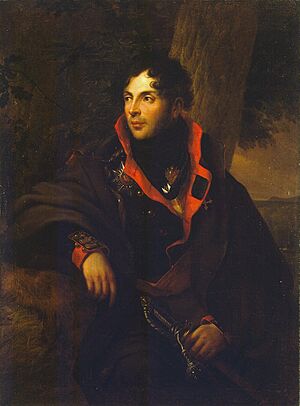
Fighting for Krutbrånet Heights
At 6:30 AM, the first Russian soldiers met Swedish outposts south of Krutbrånet. The few Swedes fought bravely but were forced to retreat. When Kamensky had 1,200 men, he ordered a general attack on Krutbrånet. The Swedish battalion there fought back. It became a fierce fight with bayonets. The Swedes were eventually overwhelmed by the larger Russian attack, which grew to about 2,500 men. A second Swedish attack was also pushed back.
Sometime after 8:30 AM, Kamensky was able to bring his cannons near the road on the heights. This gave him control of the high ground. The Swedes took a new position slightly north, at the bottom of Krutbrånet. The two armies faced each other in rough lines, less than 200 meters (650 feet) apart. The Russians stretched from the river in the east to a nearby lake in the west. The Swedes, who were outnumbered, had their left side near the river.
Wachtmeister heard the gunfire from Krutbrånet. He sent more troops, allowing battalions without ammunition to go back to Sävar to resupply. Kamensky saw the Swedish movements and ordered his left wing to go around the Swedish right side. He wanted to cut them off from the main army. As a result, the Swedish right wing moved further away from the center. The fighting continued with changing luck. The battle lines eventually stretched for about 2 kilometers (1.2 miles).
Kamensky then attacked the exposed Swedish center. But Swedish reinforcements arrived and stopped him. Swedish counterattacks, mainly by a Jönköping battalion with a cannon, pushed the Russians back along the main road. Wachtmeister failed to organize a strong attack to take advantage of this. His battalions arrived one by one and had to fight uphill. The Swedish attacks stopped against the last Russian reserve. However, two Russian generals were wounded, one of them fatally.
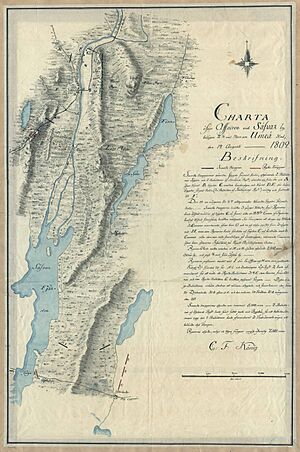
The Russian cannons at Krutbrånet controlled the battle. They fired on Swedish troops crossing the field towards the heights. Between 10:00 and 11:00 AM, Wachtmeister ordered more troops to reinforce the Swedish right. He wanted them to push back the Russian left wing and capture the cannons. But a Swedish battalion suddenly retreated near Krutbrånet. This created a big gap in the line. Another Swedish battalion had to fill the gap to prevent the center from collapsing.
The Russians were pushed back, and two more of their attacks failed. However, without enough support on the right, the Russians managed to go around the Swedish side. They marched behind their enemies, threatening to cut them off from Sävar. At 11:30 AM, Wachtmeister ordered his battalions near Krutbrånet to pull back across the river. They were also running low on ammunition. The battalions retreated one by one, with Russians chasing them. The Swedes set up defenses in front of Sävar to cover the retreat. The bridge was broken down, and troops waded across the river.
Fighting Towards Ytterboda
At 6:30 AM, Wachtmeister received a report from a Swedish outpost. It said that a Russian force of 600 men and some Cossacks had crossed the river half an hour earlier. The outpost fought as it retreated for over an hour. Then, a Swedish Jäger battalion (250 men) arrived and temporarily stopped the Russian advance. The Russians soon regrouped and pushed the Swedes back towards Sävar. At this time, Kamensky sent two more companies (250 men) over the river.
Wachtmeister thought it was just a small Russian scouting group. He sent his best units, the Queen's battalion and the Svea battalion, to help. So far, the two forces fighting towards Ytterboda were about equal in strength.
The Swedes marched in a line that stretched to a nearby lake. Around 8:00 AM, the first guard battalion met the enemy about 2.5 kilometers (1.5 miles) from Sävar, at Finnberget. The Swedes advanced quickly, taking enemy fire until they were about 10 meters (33 feet) away. Then they fired their own shots. The Russians were shaken and retreated south over Finnberget, fighting hard. Around 12:00 PM, the fighting died down as the Russians had been pushed behind Ytterboda. The Swedes marched back to Finnberget to wait for more ammunition.
However, the Russians then turned around and attacked again. Three more companies, which Kamensky had just sent over the river, attacked the Swedish battalions from behind. The left side of the Queen's battalion broke after 15 minutes of desperate fighting. It was being hit from both the side and the rear. The Svea battalion then arrived and immediately charged with bayonets, pushing the Russians away. The two battalions then joined together. At 3:00 PM, they received orders from Wachtmeister to carefully pull back towards Sävar. The Svea battalion left first. The Queen's battalion stayed near Ytterboda for another hour or two to gather scattered troops. It became clear to the Swedes that Sävar was now held by the enemy. They were completely cut off. The two battalions, mostly separated, successfully fought their way through the Russian encirclement. They reached the main army at Ratan either late that night or the next day, bringing about 70 captured Russians with them.
Swedish Retreat from Sävar
Sometime after 12:00 PM, Wachtmeister pulled his forces back across the bridge to the original Swedish defense line. Kamensky pushed his army forward to the opposite side of the river. The strong Swedish position, with their cannons firing from the heights at Sävar, stopped every attempt by Kamensky to cross the river. Kamensky thought about his next move, as he still needed to break through the Swedish lines to escape the trap.
He then learned about a shallow, unguarded crossing at the river delta. Kamensky sent his last available reserve of six companies (500–600 men) over this crossing. Half were ordered towards Sävar, and the others to attack the Swedes near Ytterboda. He also spread his forces further north along the river to threaten the Swedish right side. Around 1:00 PM, his jägers (light infantry) took control of the river bank north of Sävar and started bothering the Swedes defending it.
Meanwhile, a Swedish messenger Wachtmeister had sent south to Ytterboda quickly returned. He told the general about the Russians approaching his left side. As Wachtmeister turned his left wing to face the southern threat, the Russians forced their way across the river near the destroyed bridge. Wachtmeister seemed to be attacked from the front and both sides. He ordered a general retreat towards Djäkneboda at 2:45 PM. Three Swedish battalions with two cannons acted as a rearguard. They exchanged fire with the Russian forces occupying Sävar until they also retreated around 4:00 PM. The Russians, except for some Cossacks, were too tired and had suffered too many losses to chase them. This was the very last major battle fought in Sweden.
Who Won and Who Lost: Casualties
Swedish records estimate their losses at Sävar to be about 482 killed or captured and 362 wounded, for a total of 844 men. Kamensky said that 265 unharmed Swedes were captured and 300 wounded were "collected at the battlefield." If 270 captured is correct, then about 212 Swedes were killed. Kamensky, on the other hand, estimated the total Swedish losses at about 2,000 men.
According to Swedish records, Kamensky reported his losses as 612 killed, 738 wounded, and 260 captured. This totals 1,610 men, which includes losses from the next day's battle at Ratan. Some historians believe that the 612 killed Russians should include those missing, and that it already counts the 260 captured. This would mean about 1,350 Russian casualties in total. Other sources suggest that no more than 800 Russians were killed or wounded at Sävar, plus 200 captured, for a total of about 1,000 losses.
After the Battle: What Happened Next
Many people have criticized Wachtmeister's decision to retreat and his hesitation during the battle. Instead of pulling his troops behind the river right away, he tried to retake a good position held by the enemy. He was greatly outnumbered and had only two cannons against eight. At the key moment at Krutbrånet, he still had five battalions (groups of soldiers) in reserve. Once he pulled his forces across the river, Wachtmeister had a strong position where his cannons could finally control the area. His final position was likely too strong to be taken, even with enemy attacks on both sides.
The soldiers and officers were unhappy after the battle because they didn't feel defeated. Only the general seemed to be. Wachtmeister said he retreated because of the high number of losses. The Russians, on the other hand, had suffered more losses, but they were led by a general determined to win. Even though time was against him, Kamensky led a tired and hungry army to victory.
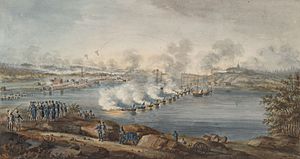
The Expedition's Result
Wachtmeister first planned to make a stand at Djäkneboda, which was a very good position. But he thought the risk of being surrounded was too great. So, he marched on towards Ratan. This allowed the Russians to use the main road to retreat. To cover the Russian retreat north, Kamensky attacked the Swedes at Ratan the next day at 3:00 PM with about 3,000 men. Wachtmeister had almost 6,000 men, but he didn't try to counterattack seriously.
After five hours of fighting, Kamensky pulled his army back to Djäkneboda. The Swedish army stayed put until August 22, when they got on their ships. Wrede and Sandels heard about the Swedish landing at Ratan on the afternoon of August 19, after the Battle of Sävar was already over. They started marching north towards Umeå the next day. Their march was slow because the retreating Russians had destroyed all the bridges behind them.
The Swedes reached the Ume River on August 21, just as the last Russian battalion was crossing. A small fight happened, followed by a cannon duel across the river. This fighting cost both sides a few dead and wounded. A small Swedish force crossed the river to Umeå and attacked the Russian field hospital, taking some prisoners. On August 22, Kamensky ordered a general retreat because he was afraid of being cut off again. The last Russian battalion left Umeå on August 23 and Djäkneboda the next day. The retreat continued towards Piteå, where Kamensky arrived on August 29. Wrede marched into Umeå on August 24.
Instead of sailing north right away to cut off the Russian retreat, Puke was happy with securing Umeå. Wachtmeister landed again at Ratan on August 28 and marched towards the city. The fleet also sailed there the next day. The two Swedish forces finally met at their planned spot, but it was a little too late.
Even though Kamensky had been forced out of Västerbotten for a short time, the Swedish mission failed to destroy the Russian army. Wachtmeister's extreme caution and the poor teamwork between the two Swedish forces were key reasons for this failure. The expedition cost the Swedes a total of 1,077 men killed, wounded, or captured. Russian casualties were between 1,539 and 1,610 men.
On August 25, Kamensky defended his forts at the Pite River from a Swedish attack. The Swedes wanted to cut off his supply lines north. The Swedes lost 23–25 men, while the Russians lost 33–50. This was the last action of the war. On September 2, the two sides agreed to stop fighting. This lasted until the Treaty of Fredrikshamn was signed. Sweden gave up its eastern lands (Finland) to Russia, including the Åland Islands. Kamensky's retreat from Västerbotten, which many Russians were initially disappointed by, likely helped make Alexander I's demands less harsh. The peace was followed by other treaties that ended other conflicts and made Sweden join the Continental System against the United Kingdom.


